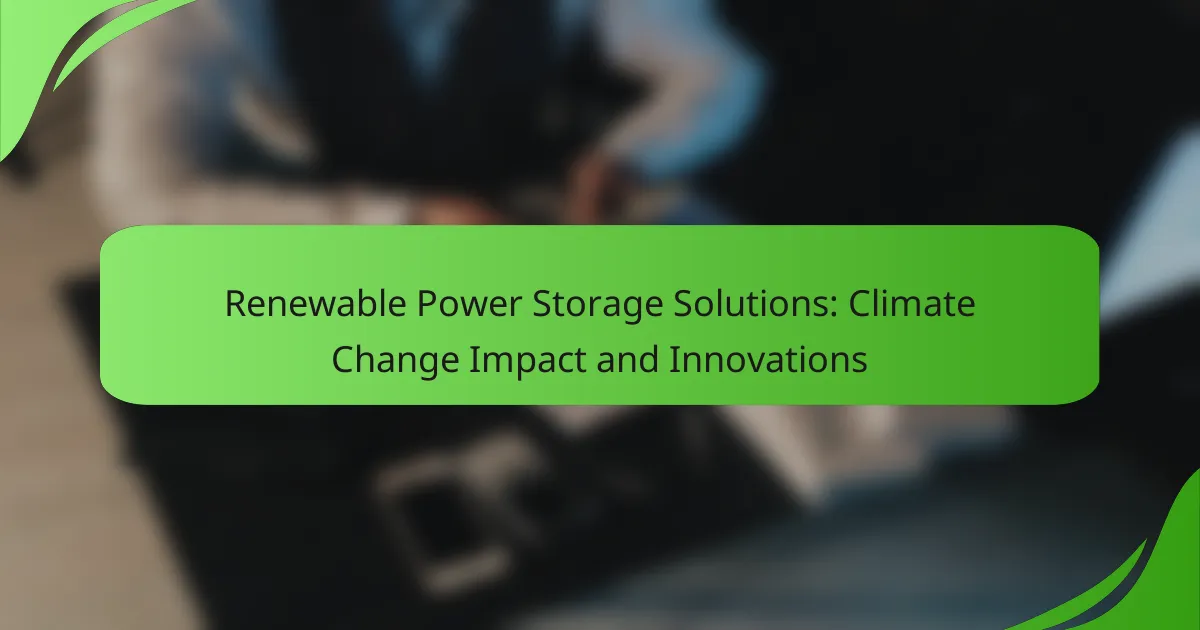Renewable power storage solutions play a vital role in combating climate change by efficiently storing energy from renewable sources, ensuring a consistent power supply. As reliance on intermittent energy sources like solar and wind grows, these technologies help balance energy demand and minimize dependence on fossil fuels, thereby reducing greenhouse gas emissions. Innovations in this field focus on enhancing efficiency, capacity, and sustainability, which are essential for a reliable energy future.
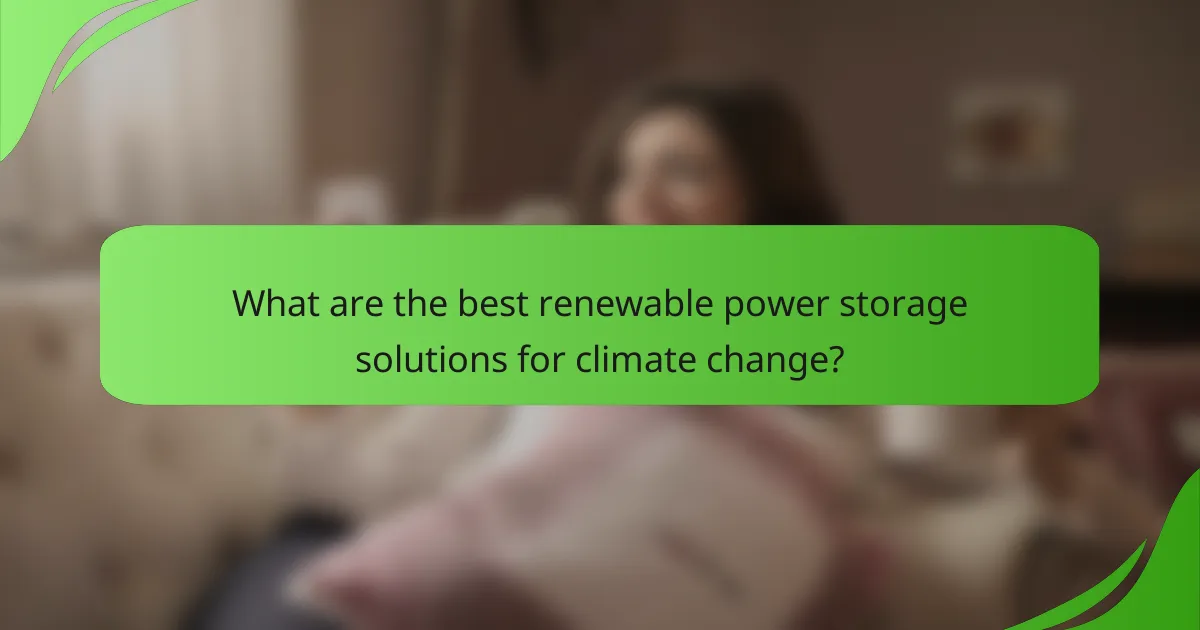
What are the best renewable power storage solutions for climate change?
The best renewable power storage solutions for climate change include technologies that efficiently store energy generated from renewable sources, enabling a reliable power supply. These solutions are crucial for balancing energy demand and supply, especially with the increasing reliance on intermittent sources like solar and wind.
Lithium-ion batteries
Lithium-ion batteries are widely used for energy storage due to their high energy density and efficiency. They work by moving lithium ions between the anode and cathode during charging and discharging, making them suitable for applications ranging from electric vehicles to grid storage.
However, their production involves significant resource extraction and environmental concerns. It’s essential to consider recycling options and the lifecycle impact when implementing lithium-ion solutions.
Pumped hydro storage
Pumped hydro storage is a mature technology that uses two water reservoirs at different elevations. Energy is stored by pumping water uphill during low demand and released to generate electricity when needed. This method is highly efficient, with round-trip efficiencies often exceeding 70%.
While effective, pumped hydro requires specific geographical conditions and significant infrastructure investment. It is most suitable for large-scale applications and can take years to develop.
Compressed air energy storage
Compressed air energy storage (CAES) involves compressing air in underground caverns during periods of low demand and releasing it to drive turbines for electricity generation during peak demand. This technology can store large amounts of energy and is particularly useful for balancing grid loads.
CAES systems can be less efficient compared to other storage methods, often achieving efficiencies around 50-70%. Site selection is critical, as suitable geological formations are necessary for effective implementation.
Flow batteries
Flow batteries store energy in liquid electrolytes contained in external tanks, allowing for scalable energy storage. They can be charged and discharged simultaneously, making them ideal for renewable energy integration and grid stability.
While flow batteries have a longer lifespan and lower environmental impact than lithium-ion batteries, they typically have lower energy density and higher initial costs. They are best suited for stationary applications where space and budget allow for larger systems.
Thermal energy storage
Thermal energy storage systems store excess energy in the form of heat, which can be used later for electricity generation or heating. Common methods include molten salt storage and ice storage, which are particularly effective for solar thermal power plants and district heating systems.
This technology can provide significant flexibility and efficiency, especially in regions with high solar potential. However, the initial setup can be costly, and the systems require careful design to maximize efficiency and minimize heat loss.

How do renewable power storage solutions impact climate change?
Renewable power storage solutions significantly reduce the impact of climate change by enabling the effective use of clean energy sources. These technologies help to store excess energy generated from renewable sources, minimizing reliance on fossil fuels and decreasing greenhouse gas emissions.
Reduction of greenhouse gas emissions
By storing energy from renewable sources like solar and wind, power storage solutions help to reduce greenhouse gas emissions. When energy is stored, it can be used during peak demand times, decreasing the need for fossil fuel-based power generation.
For instance, battery storage systems can capture excess solar energy generated during the day and release it during the evening, when demand is higher. This process can lead to a reduction in emissions by up to 50% in regions heavily reliant on coal and natural gas.
Enhanced grid stability
Power storage solutions enhance grid stability by providing backup energy during outages and balancing supply and demand. This capability is crucial as more renewable energy sources are integrated into the grid, which can be intermittent.
Energy storage systems, such as pumped hydro or lithium-ion batteries, can quickly respond to fluctuations in energy supply, ensuring a steady flow of electricity. This responsiveness helps prevent blackouts and maintains the reliability of the power grid.
Facilitation of renewable energy adoption
Renewable power storage solutions facilitate the adoption of renewable energy by addressing the intermittency issues associated with sources like solar and wind. By providing a reliable means to store energy, these technologies encourage more investments in renewables.
For example, regions that implement energy storage systems often see an increase in solar panel installations, as homeowners and businesses feel more confident in their ability to utilize the energy generated. This trend can lead to a significant shift towards cleaner energy sources, further mitigating climate change impacts.
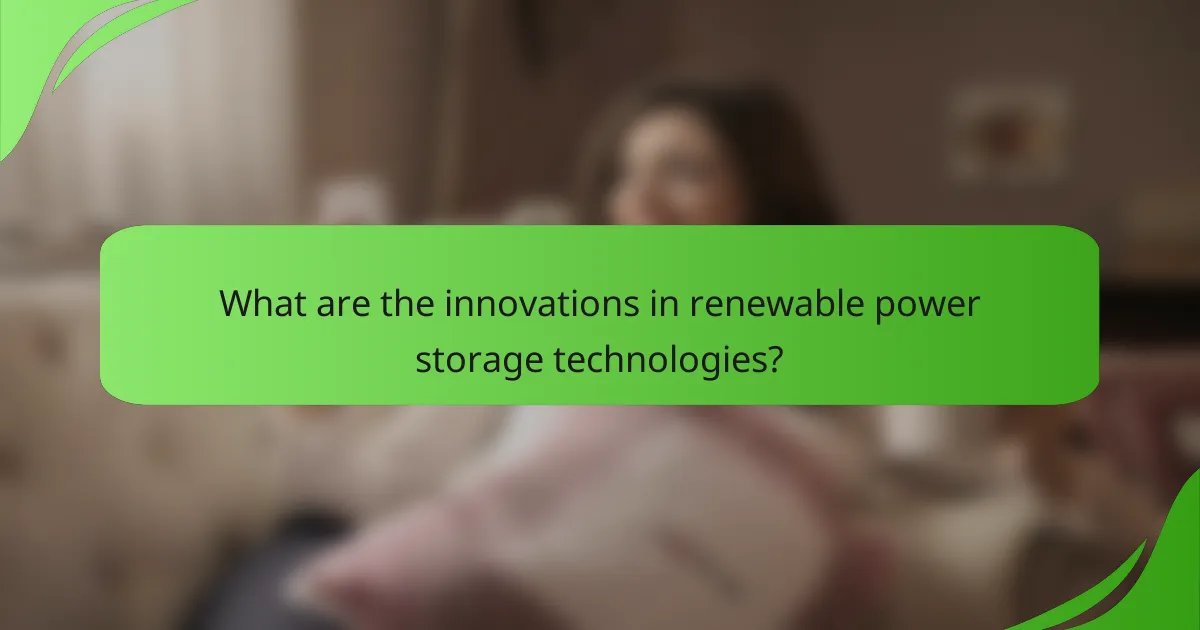
What are the innovations in renewable power storage technologies?
Innovations in renewable power storage technologies focus on improving efficiency, capacity, and sustainability. These advancements are crucial for addressing the intermittent nature of renewable energy sources like solar and wind, enabling a more reliable energy supply.
Solid-state batteries
Solid-state batteries represent a significant leap in energy storage technology, using solid electrolytes instead of liquid ones. This design enhances safety by reducing the risk of leaks and fires, while also increasing energy density, which can lead to longer-lasting power sources.
These batteries are particularly promising for electric vehicles and grid storage, with potential energy densities reaching up to 300 Wh/kg. However, challenges remain in scaling production and reducing costs, which are currently higher than traditional lithium-ion batteries.
Advanced supercapacitors
Advanced supercapacitors offer rapid charging and discharging capabilities, making them ideal for applications requiring quick bursts of energy. They can charge in seconds and provide power for short durations, which complements traditional batteries in hybrid systems.
While supercapacitors have lower energy density compared to batteries, their longevity and cycle stability make them suitable for applications like regenerative braking in vehicles and smoothing out power fluctuations in renewable energy systems. Their integration with other storage technologies can optimize overall performance.
Hydrogen storage systems
Hydrogen storage systems convert excess renewable energy into hydrogen through electrolysis, which can then be stored and used later for power generation. This method provides a versatile solution for long-term energy storage, addressing seasonal energy imbalances.
Hydrogen can be stored in various forms, including compressed gas, liquid hydrogen, or chemical compounds. While the technology is still developing, it offers a promising pathway for achieving energy independence and reducing carbon emissions, particularly in sectors difficult to electrify, such as heavy industry and transportation.
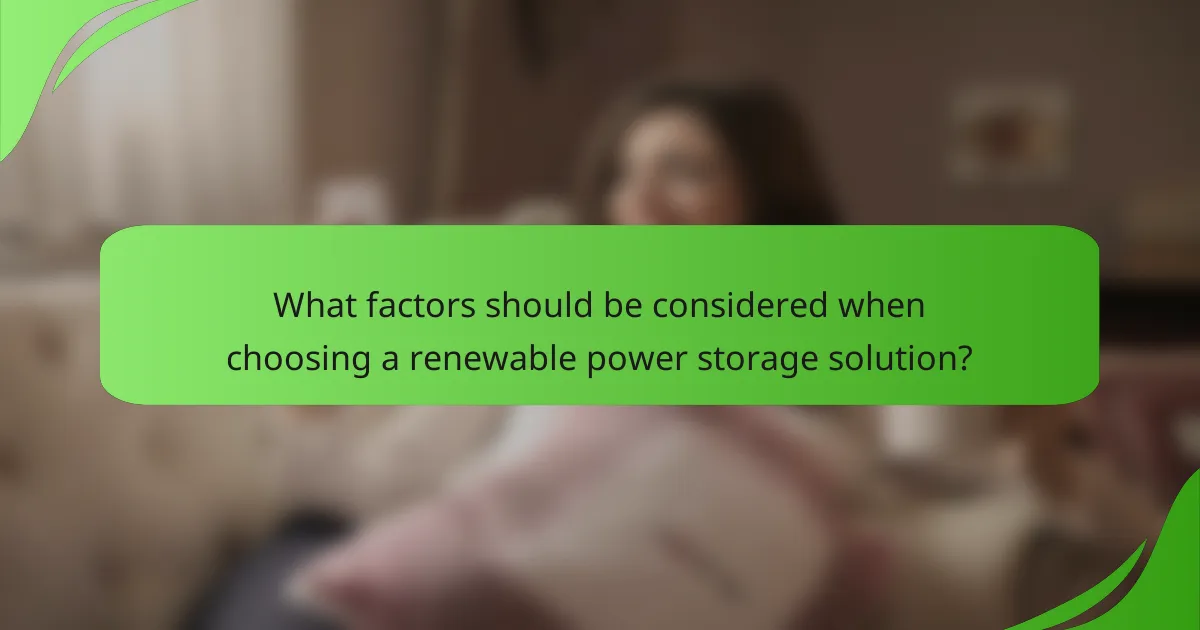
What factors should be considered when choosing a renewable power storage solution?
When selecting a renewable power storage solution, key factors include cost-effectiveness, energy density, scalability, and environmental impact. Each aspect plays a crucial role in determining the overall efficiency and viability of the storage system in supporting renewable energy sources.
Cost-effectiveness
Cost-effectiveness is a primary consideration when evaluating renewable power storage solutions. This includes both initial investment and long-term operational costs. Technologies like lithium-ion batteries may have higher upfront costs but can offer lower maintenance and replacement expenses over time.
When comparing options, consider the total cost of ownership, which encompasses installation, maintenance, and potential savings from energy efficiency. Look for solutions that provide a favorable balance between upfront costs and long-term savings.
Energy density
Energy density refers to the amount of energy stored per unit volume or weight, which is critical for determining how much energy can be stored in a given space. Higher energy density means less physical space is required for storage, making it ideal for urban settings or limited areas.
For example, lithium-ion batteries typically have higher energy densities compared to lead-acid batteries, allowing for more compact installations. When assessing energy density, consider the specific application and space constraints to ensure optimal performance.
Scalability
Scalability is the ability to expand the storage system as energy demands grow. A scalable solution allows for incremental investments, making it easier to adapt to changing energy needs without overcommitting resources upfront.
Consider systems that can be easily integrated with additional units or technologies. For instance, modular battery systems can be expanded by adding more units as energy requirements increase, providing flexibility for future growth.
Environmental impact
The environmental impact of renewable power storage solutions is crucial for sustainability. Assess the lifecycle of materials used, energy consumption during production, and end-of-life disposal or recycling options. Solutions with lower carbon footprints and minimal ecological disruption are preferable.
For example, while lithium-ion batteries are widely used, their mining and disposal processes can pose environmental challenges. Alternatives like flow batteries or recycled materials may offer more sustainable options. Always consider the full environmental implications when making a choice.
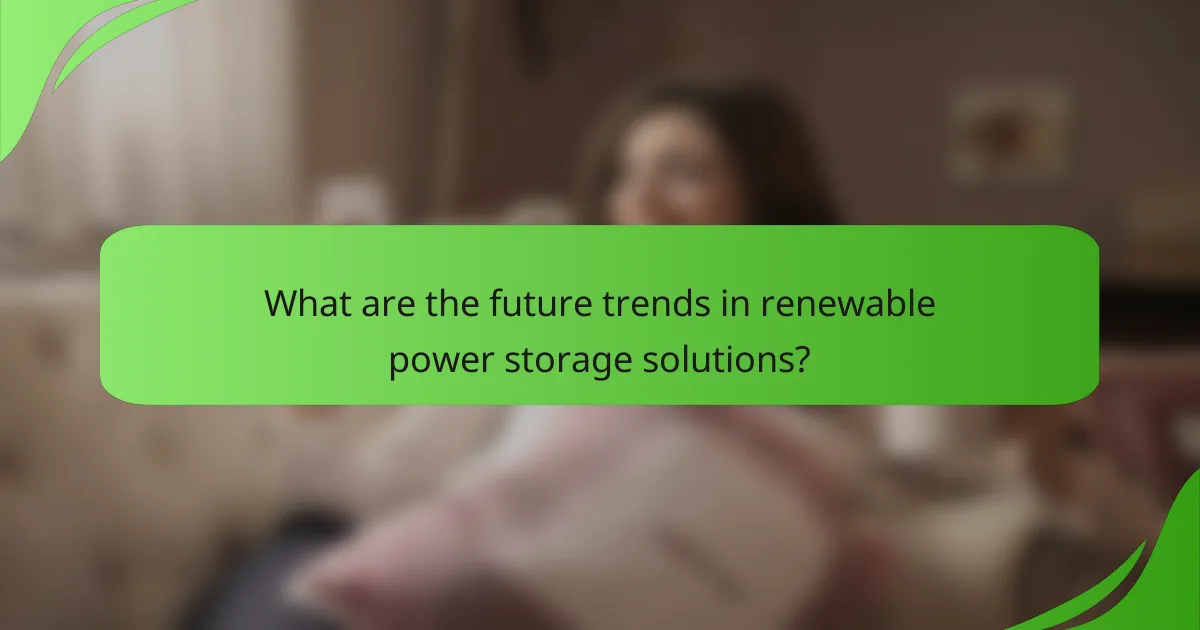
What are the future trends in renewable power storage solutions?
Future trends in renewable power storage solutions focus on improving efficiency, reducing costs, and enhancing integration with renewable energy sources. Innovations in battery technology, including solid-state batteries and flow batteries, are expected to play a significant role in meeting energy demands sustainably.
Advancements in Battery Technology
Advancements in battery technology are crucial for the future of renewable power storage. Solid-state batteries, which use a solid electrolyte instead of liquid, promise higher energy density and improved safety. Flow batteries, on the other hand, offer scalability and longer discharge times, making them suitable for large-scale energy storage.
These technologies are evolving rapidly, with research indicating that solid-state batteries could reduce costs significantly over the next decade. Companies are investing heavily in these innovations to enhance performance and lower the environmental impact of battery production.
Integration with Smart Grids
Integration with smart grids is another key trend in renewable power storage solutions. Smart grids utilize digital technology to manage electricity demand and supply more efficiently. By incorporating energy storage systems, these grids can balance intermittent renewable energy sources like solar and wind, ensuring a stable energy supply.
For example, during peak solar production hours, excess energy can be stored and released during periods of high demand. This capability not only enhances grid reliability but also reduces reliance on fossil fuels, contributing to lower carbon emissions.
Regulatory and Economic Factors
Regulatory and economic factors are shaping the landscape of renewable power storage solutions. Governments worldwide are implementing policies and incentives to promote energy storage technologies, such as tax credits and grants. These measures aim to accelerate the transition to a low-carbon economy.
In Europe, for instance, the European Union has set ambitious targets for renewable energy adoption, which includes significant investments in energy storage. Understanding local regulations and available incentives can help businesses and consumers make informed decisions about investing in renewable storage solutions.
